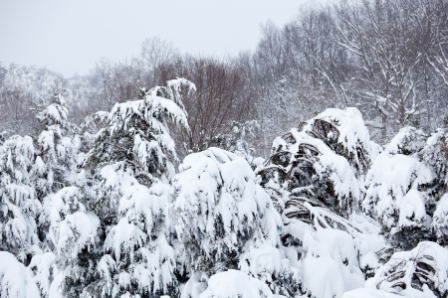
Damage to our favorite trees and shrubs can happen. Sometimes the damage is the result of heavy snowfall. Or sometimes a large dog, horse, pony, donkey whatever it might be, decides to eat part of a tree. Small trees are also frequently physically damaged by kids, cars or other means.
Recently somebody wrote to me about a precious Japanese maple in her yard that had numerous broken branches from heavy snowfall that clung to the tree weighing down the branches and breaking some of them. After responding to her concern I decided to address this issue in more detail.
In this article I’m going to talk specifically about a Japanese maple tree, but it really doesn’t matter what kind of plant you have that is damaged, the same principles apply. After a heavy snow storm has hit you notice that your Laceleaf Weeping Japanese maple has one or more sizable branches that have snapped off and are still hanging by the bark. The first thought is to pull the branches back in place then attempting to secure it back together using duct tape or another type of binding. Will that work? It could, but in most cases I don’t think you are going to be successful because of a lot of factors like how long the wound was exposed to the air and what the conditions around the plant like are like after you make the repair, etc.
In most cases, I would suggest that you simply remove the broken branches, then take a sharp knife and trim the bark around the open wound. Remove any frayed edges or loose pieces of bark so water and insects cannot get behind the bark. With your knife taper the edges of the wound so when rain water hits the open wound the water runs off the wound smoothly. This will allow that area to remain clean and dry as the tree heals itself.
Now realize that after you remove the broken branches your tree will have large holes where there are no branches and for the most it will look unsightly. But chances are the tree will survive just fine so it deserves a chance to repair itself with a little help from you. After removing everything that has to be removed, stand back and inspect your tree to see if you can do additional pruning to balance the tree a little. If so, go ahead and do that pruning so when the tree does bounce back it won’t grow completely out of proportion.
Should you seal the wounds with tree paint or other compounds? Most experts today acknowledge that sealing a wound with tree paint really doesn’t do any thing to help the tree. Most suggest just letting nature heal the wounds just as would happen in a natural setting.
After all of the pruning is done waiting is the only thing left to do. I suggest snapping a few pictures of your tree right after you finish pruning it because in one, two or three years you’ll want to look back in amazement at how well the tree has bounced back and will be amazed with the recovery that your tree makes.
Mike McGroarty is the owner of McGroarty Enterprises and the author of several books. You can visit his website at Freeplants.com and read his blog at MikesBackYardNursery.com.
Related Articles
Plant Propagation Calendar – What You Should Be Doing Each Month of the Year
Proper Mulching is One of the Best Things You Can do for Your Plants



Comment here